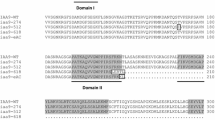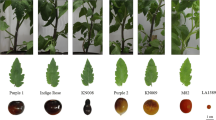Abstract
Tomato Cyc-B gene encodes a chromoplast-specific lycopene β-cyclase that converts lycopene to β-carotene during ripening of the fruit. By screening the tomato Red Setter mutant population with the TILLING method, we identified eight new alleles at the Cyc-B locus. Results of greenhouse phenotypic analysis revealed that the novel A949G Cyc-B allele produced modifications in the carotenoid profile and content of tomato petals and fruit. The cyc-b7 genotype, carrying the A949G Cyc-B allele, was therefore evaluated in an open field trial for standard agronomic traits as well as carotenoid content of the fruit. Results of the field trial confirmed that the induced A949G missense mutation favored the accumulation of lycopene in the fruit with no detrimental effects on the yield or on other agronomic and technological properties such as fruit firmness and Brix degree of fruit juice. On the basis of these results, it can be affirmed that the A949G Cyc-B allele constitutes a useful new genetic variant which can be used for improving carotenoid content in tomato fruit and for the development of new tomato commercial lines. Finally, the results presented here furthermore demonstrate that TILLING is a powerful methodology not only as a confirmatory system for gene functional analysis but also for selecting new gene variants useful for genetic improvement of important crops.

Similar content being viewed by others
References
Bartley GE, Scolnik PA (1995) Plant carotenoid: pigments for photoprotection, visual attraction, and human health. Plant Cell 7:1027–1038
Bassi R, Pineau B, Dainese P, Marquardt J (1993) Carotenoid-binding proteins of photosystem II. Eur J Biochem 212:297–303
Bouvier F, d’Harlingue A, Backhaus RA, Kumagai MH, Camara B (2000) Identification of neoxanthin synthase as a carotenoid cyclase paralog. Eur J Biochem 267:6346–6352
Britton G (1995) Structure and properties of carotenoids in relation to function. FASEB J 9:1551–1558
Caldwell DG, McCallum N, Shaw P, Muehlbauer GJ, Marshall DF, Waugh R (2004) A structured mutant population for forward and reverse genetics in Barley (Hordeum vulgare L.). Plant J 40(1):143–150
Dahmani-Mardas F, Troadec C, Boualem A, Lévêque S, Alsadon AA et al (2010) Engineering melon plants with improved fruit shelf life using the TILLING approach. PLoS One 5(12):e15776
Dalal M, Chinnusamy V, Bansal KC (2010) Isolationl and functional characterization of lycopene β-cyclase (CYC-B) promoter from Solanum habrochaites. BMC Plant Biol 10:61
Dalmais M, Schmidt J, Le Signor C, Moussy F, Burstin J, Savois V, Aubert G, Brunaud V, de Oliveira Y, Guichard C et al (2008) UTILLdb, a Pisum sativum in silico forward and reverse genetics tool. Genome Biol 9(2):R43
D’Ambrosio C, Stigliani AL, Giorio G (2011) Overexpression of CrtR-b2 (carotene beta hydroxylase 2) from S. lycopersicum L. differentially affects xanthophyll synthesis and accumulation in transgenic tomato plants. Transgenic Res 20(1):47–60
Eisenreich W, Rohdich F, Bacher A (2001) Deoxyxylulose phosphate pathway to terpenoids. Trends Plant Sci 6:78–84
Gady ALF, Vriezen WH, Van de Wal MHBJ, Huang P, Bovy AG, Visser RGF, Bachem CWB (2012) Induced point mutations in the phytoene synthase 1 gene cause differences in carotenoid content during tomato fruit ripening. Mol Breed 29:801–812. doi:10.1007/s11032-011-9591-9
Hadley CW, Miller EC, Schwartz SJ, Clinton SK (2002) Tomatoes, lycopene, and prostate cancer: progress and promise. Exp Biol Med 227:869–880
Hirschberg J (2001) Carotenoid biosynthesis in flowering plants. Curr Opin Plant Biol 4:210–218
Hunter WN (2007) The non-mevalonate pathway of isoprenoid precursor biosynthesis. J Biol Chem 282:21573–21577
Krinsky NI, Johnson EJ (2005) Carotenoid actions and their relation to health and disease. Mol Aspects Med 26:459–516
Lakshman MR, Okoh C (1993) Enzymatic conversion of all trans-beta-carotene to retinal. Meth Enzymol 214:256–269
Lindgren L, Stahlberg KG, Hoglund AS (2003) Seed-specific overexpression of an endogenous Arabidopsis phytoene synthase gene results in delayed germination and increased levels of carotenoids, chlorophyll, and abscisic acid. Plant Physiol 132:779–785
McCallum CM, Comai L, Greene EA, Henikoff S (2000) Targeting induced local lesions in genomes (TILLING) for plant functional genomics. Plant Physiol 123(2):439–442
Minoia S, Petrozza A, D’Onofrio O, Piron F, Mosca G, Sozio G, Cellini F, Bendahmane A, Carriero F (2010) A new mutant genetic resource for tomato crop improvement by TILLING technology. BMC Res Notes 3:69
Mordente A, Guantario B, Meucci E, Silvestrini A, Lombardi E, Martorana GE, Giardina B, Böhm V (2011) Lycopene and cardiovascular diseases: an update. Curr Med Chem 18(8):1146–1163
Ng P, Henikoff S (2003) SIFT: predicting amino acid changes that affect protein function. Nucleic Acids Res 31:3812–3814
Okabe Y, Asamizu E, Saito T, Matsukura C, Ariizumi T, Brès C, Rothan C, Mizoguchi T, Ezura H (2011) Tomato TILLING technology: development of a reverse genetics tool for the efficient isolation of mutants from Micro-Tom mutant libraries. Plant Cell Physiol 52(11):1994–2005
Pecker I, Gabbay R, Cunningham FX Jr, Hirschberg J (1996) Cloning and characterization of the cDNA for lycopene beta-cyclase from tomato reveals decrease in its expression during fruit ripening. Plant Mol Biol 30(4):807–819
Piron F, Nicolai M, Minoia S, Piednoir E, Moretti A et al (2010) An induced mutation in tomato eIF4E leads to immunity to two potyviruses. PLoS One 5(6):e11313
Rock CD, Zeevaart JAD (1991) The aba mutant of Arabidopsis thaliana is impaired in epoxy-carotenoid biosynthesis. Proc Natl Acad Sci USA 88:7496–7499
Ronen G, Carmel-Goren L, Zamir D, Hirschberg J (2000) Analternative pathway to beta-carotene formation in plant chromoplasts discovered by map-based cloning of beta and old-gold color mutations in tomato. Proc Natl Acad Sci USA 97:11102–11107
Rozen S, Skaletsky HJ (2000) Primer3 on the WWW for general users and for biologist programmers. In: Krawetz S, Misener S (eds) Bioinformatics methods and protocols: methods in molecular biology. Humana Press, Totowa, pp 365–386
Slade AJ, Fuerstenberg SI, Loeffler D, Steine MN, Facciotti D (2005) A reverse genetic, nontransgenic approach to wheat crop improvement by TILLING. Nat Biotechnol 23:75–81
Stigliani AL, Giorio G, D’Ambrosio C (2011) Characterization of P450 carotenoid β- and ε-hydroxylases of tomato and transcriptional regulation of xanthophyll biosynthesis in root, leaf, petal and fruit. Plant Cell Physiol 52:851–865
Till BJ, Reynolds SH, Weil C, Springer N, Burtner C, Young K, Bowers E, Codomo CA, Enns LC, Odden AR, Greene EA, Comai L, Henikoff S (2004) Discovery of induced point mutations in maize genes by TILLING. BMC Plant Biol 4:12
Till BJ, Cooper J, Tai TH, Colowit P, Greene EA, Henikoff S, Comai L (2007) Discovery of chemically induced mutations in rice by TILLING. BMC Plant Biol 7:19
Triques K, Sturbois B, Gallais S, Dalmais M, Chauvin S, Clepet C, Aubourg S, Rameau C, Caboche M, Bendahmane A (2007) Characterization of Arabidopsis thaliana mismatch specific endonucleases: application to mutation discovery by TILLING in pea. Plant J 51(6):1116–1125
Ye X, Al-Babili S, Kloti A, Zhang J, Lucca P, Beyer P, Potrykus I (2000) Engineering the provitamin A (β-carotene) biosynthetic pathway into (carotenoid-free) rice endosperm. Science 287:303–305
Acknowledgments
This work was funded by the Italian Ministry of University and Research (MIUR, ITALYCO Project, DD no. 603/RIC) and by the European project EU-SOL (Contract number: FOOD-CT-2006-016214) through the 6th framework programme. The authors thank Dr. Michele Quitadamo for hosting the field trial at “Centro per la Sperimentazione e la Valorizzazione delle Colture Mediterranee” in Foggia, Dr. Stephan Summerer for reviewing the English, and colleagues of Metapontum Agrobios for their help throughout all phases of the project.
Author information
Authors and Affiliations
Corresponding author
Electronic supplementary material
Below is the link to the electronic supplementary material.
Rights and permissions
About this article
Cite this article
Silletti, M.F., Petrozza, A., Stigliani, A.L. et al. An increase of lycopene content in tomato fruit is associated with a novel Cyc-B allele isolated through TILLING technology. Mol Breeding 31, 665–674 (2013). https://doi.org/10.1007/s11032-012-9824-6
Received:
Accepted:
Published:
Issue Date:
DOI: https://doi.org/10.1007/s11032-012-9824-6




